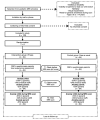Comparing Smartphone Virtual Reality Exposure Preparation to Care as Usual in Children Aged 6 to 14 Years Undergoing Magnetic Resonance Imaging: Protocol for a Multicenter, Observer-Blinded, Randomized Controlled Trial
- PMID: 36692931
- PMCID: PMC9906306
- DOI: 10.2196/41080
Comparing Smartphone Virtual Reality Exposure Preparation to Care as Usual in Children Aged 6 to 14 Years Undergoing Magnetic Resonance Imaging: Protocol for a Multicenter, Observer-Blinded, Randomized Controlled Trial
Abstract
Background: A magnetic resonance imaging (MRI) procedure can cause preprocedural and periprocedural anxiety in children. Psychosocial interventions are used to prepare children for the procedure to alleviate anxiety, but these interventions are time-consuming and costly, limiting their clinical use. Virtual reality (VR) is a promising way to overcome these limitations in the preparation of children before an MRI scan.
Objective: The objective of this study is (1) to develop a VR smartphone intervention to prepare children at home for an MRI procedure; and (2) to examine the effect of the VR intervention in a randomized controlled trial, in which the VR intervention will be compared to care as usual (CAU). CAU involves an information letter about an MRI examination. The primary outcome is the child's procedural anxiety during the MRI procedure. Secondary outcomes include preprocedural anxiety and parental anxiety. We hypothesize that the VR preparation will result in a higher reduction of the periprocedural anxiety of both parents and children as compared to CAU.
Methods: The VR intervention provides a highly realistic and child-friendly representation of an MRI environment. In this randomized controlled trial, 128 children (aged 6 to 14 years) undergoing an MRI scan will be randomly allocated to the VR intervention or CAU. Children in the VR intervention will receive a log-in code for the VR app and are sent cardboard VR glasses.
Results: The VR smartphone preparation app was developed in 2020. The recruitment of participants is expected to be completed in December 2022. Data will be analyzed, and scientific papers will be submitted for publication in 2023.
Conclusions: The VR smartphone app is expected to significantly reduce pre- and periprocedural anxiety in pediatric patients undergoing an MRI scan. The VR app offers a realistic and child-friendly experience that can contribute to modern care. A smartphone version of the VR app has the advantage that children, and potentially their parents, can get habituated to the VR environment and noises in their own home environment and can do this VR MRI preparation as often and as long as needed.
Trial registration: ISRCTN Registry ISRCTN20976625; https://www.isrctn.com/ISRCTN20976625.
International registered report identifier (irrid): DERR1-10.2196/41080.
Keywords: MRI; MRI preparation; MRI scans; VR; anxiety; children; imaging; magnetic resonance imaging; procedural anxiety; psychosocial intervention; randomized controlled trial; smartphone intervention; smartphone virtual reality; virtual reality.
©Zita van Spaendonck, Koen Pieter Leeuwenburgh, Marjolein Dremmen, Joost van Schuppen, Daniëlle Starreveld, Bram Dierckx, Jeroen S Legerstee. Originally published in JMIR Research Protocols (https://www.researchprotocols.org), 24.01.2023.
Conflict of interest statement
Conflicts of Interest: None declared.
Figures



Similar articles
-
Development of a Virtual Reality Exposure Tool as Psychological Preparation for Elective Pediatric Day Care Surgery: Methodological Approach for a Randomized Controlled Trial.JMIR Res Protoc. 2017 Sep 11;6(9):e174. doi: 10.2196/resprot.7617. JMIR Res Protoc. 2017. PMID: 28893727 Free PMC article.
-
Comparing a Virtual Reality-Based Simulation App (VR-MRI) With a Standard Preparatory Manual and Child Life Program for Improving Success and Reducing Anxiety During Pediatric Medical Imaging: Randomized Clinical Trial.J Med Internet Res. 2021 Sep 22;23(9):e22942. doi: 10.2196/22942. J Med Internet Res. 2021. PMID: 34550072 Free PMC article. Clinical Trial.
-
The Efficacy of Virtual Reality Game Preparation for Children Scheduled for Magnetic Resonance Imaging Procedures (IMAGINE): Protocol for a Randomized Controlled Trial.JMIR Res Protoc. 2022 Jun 13;11(6):e30616. doi: 10.2196/30616. JMIR Res Protoc. 2022. PMID: 35700000 Free PMC article.
-
A systematic review of the use of virtual reality or dental smartphone applications as interventions for management of paediatric dental anxiety.BMC Oral Health. 2021 May 7;21(1):244. doi: 10.1186/s12903-021-01602-3. BMC Oral Health. 2021. PMID: 33962624 Free PMC article.
-
Effectiveness of virtual reality in managing pain and anxiety in adults during periprocedural period: a systematic review and meta-analysis.Langenbecks Arch Surg. 2023 Aug 9;408(1):301. doi: 10.1007/s00423-023-03046-5. Langenbecks Arch Surg. 2023. PMID: 37556082
Cited by
-
Improving Pediatric Patients' Magnetic Resonance Imaging Experience With an In-Bore Solution: Design and Usability Study.JMIR Serious Games. 2025 Feb 13;13:e55720. doi: 10.2196/55720. JMIR Serious Games. 2025. PMID: 39946688 Free PMC article.
-
A systematic literature review on integrating AI-powered smart glasses into digital health management for proactive healthcare solutions.NPJ Digit Med. 2025 Jul 5;8(1):410. doi: 10.1038/s41746-025-01715-x. NPJ Digit Med. 2025. PMID: 40617964 Free PMC article.
References
-
- Westra AE, Zegers MPA, Sukhai RN, Kaptein AA, Holscher HC, Ballieux BEPB, van Zwet EW, Wit JM. Discomfort in children undergoing unsedated MRI. Eur J Pediatr. 2011 Jun;170(6):771–7. doi: 10.1007/s00431-010-1351-z. https://europepmc.org/abstract/MED/21120526 - DOI - PMC - PubMed
LinkOut - more resources
Full Text Sources

